We are still gathering 2025 data on the climate opinions of Tahoe's residents and visitorsif you would like to contribute please participate in this quick 10 question survey.
Stories of Climate, Hope, and Resilience
The exhibit shares just a glimpse of the inspiring actions people are taking in the Tahoe Basin, scroll down to discover their full stories and even more inspiring examples.
Featured Stories of Action and Hope

Adilene De La Torre (conservation education specialist, Tahoe born and raised)Adilene felt disconnected from nature until she volunteered and interned with Generation Green, a summer work-study program integrating high school students with the outdoors. Through Generation Green, she went backpacking for the first time! Adilene was inspired to become a conservation educator with the Lake Tahoe Basin Management Unit, teaching local youth about the environment and encouraging them to connect with nature. Now, Adilene helps run the Generation Green program, fostering future generations of environmental stewards. Adilene has made the outdoors more inclusive, promoting tours and information in other languages so that “folks feel comfortable going out and enjoying nature, and it’s not something that might feel foreign.” Adilene’s advice: volunteer, pick up litter, recreate responsibly, and respect nature—including environmental regulations, which provide “extra care” for nature. Adilene strives to work with the community and meet their needs while ensuring that “they feel like they are stewards… and help take care of Tahoe.” |

Alison Toy (Education programs and facilities manager, snowboards with scientists, mom raising an environmental steward)Alison is the education programs and facilities manager at the UC Davis Tahoe Environmental Research Center as well as creator of the TERC program Ski with a Scientist. She advocates for greater educational opportunities so that people can gain a deeper understanding of current environmental changes and learn how we can be a part of the solution. She notes that “one of the most powerful things is the ability to connect and have a conversation with people,” encouraging us to find common ground and use that as a starting point for discussions about environmental changes and solutions. The Ski with a Scientist Program taps into the skiing and snowboarding community, leveraging the love for snow sports to inspire conservation efforts that help preserve these activities for future generations. Alison remarks, “We have seen collective action make a difference,” as with the two-stroke engine ban on Lake Tahoe, the single-use plastic ban in South Lake Tahoe, and reduced plastic straw usage in Truckee. She recalls that when she found a ruptured floatie leaking thousands of Styrofoam balls into Lake Tahoe, within minutes of a call to action on social media, the environmental community rallied to clean up this pollution. Everyone can get involved in protecting the environment; Alison advises us to attend environmental events, volunteer, and participate in community events, all of which foster our learning and connections. Finally, Alison finds hope in youth activism and the powerful motivation of future generations. She describes, “I really want to make sure that my daughter has the best environment possible left for her.” |

Andrew Schwartz (UC Berkeley Central Sierra Snow Laboratory director, “science nerd”)Andrew researches how environmental change impacts snowpack and water storage at the UC Berkeley Central Sierra Snow Laboratory. His findings move through a “research to operations pipeline,” informing science and policy decisions aimed at mitigating and adapting to environmental change. Andrew is passionate about how humans fit into the natural system, and how he can support outdoor spaces for the health of both the planet and people. Community members can learn more about Andrew’s research through snow science snowshoe tours at Donner Memorial State Park. Andrew’s advice: “Use your senses and pay attention to what the snow is doing.” This citizen science is vital to his lab’s discoveries, which can translate to environmental solutions. Andrew suggests making your voice heard at local meetings; “Coming together with your local community and going forward as a larger collective can really impact the world.” |

Brennan LaGasse (sustainability educator and activist, mountain guide)Brennan is a sustainability professor at the University of Nevada, Reno at Lake Tahoe. He roots sustainability in Indigenous worldviews such as stewardship, reciprocity, and intergenerationality. Brennan describes himself as a “bridge where knowledge has been made available to [him],” sharing this knowledge with students. Because “education is a vehicle for action,” Brennan is not only a professor, but also an environmental activist. He runs Informed Experiences, a nonprofit organization making place-based experiential learning opportunities accessible and equitable. To Brennan, “the world doesn’t have to be as harsh as it is for so many.” An overarching environmental solution is systemic change towards regenerative ways of being and alternative forms of economy. However, this change depends on smaller scale, local community-driven action. Brennan’s advice: “Incremental acts lead to cumulative change.” Start by learning more, supporting the groups taking action, and caring for others and yourself so that you can continue taking action. “There’s a place for everybody” in environmental solution-making. |

Chris Joseph (Keep Tahoe Blue communications director, Tahoe lover)Chris is the communications director at Keep Tahoe Blue, an environmental nonprofit dedicated to protecting and restoring Lake Tahoe. As environmental changes threaten the Tahoe Basin, Keep Tahoe Blue advocates for policies and funding to support ecosystem health. Keep Tahoe Blue also leads environmental restoration initiatives; for example, they helped the California Tahoe Conservancy acquire land with the intention of restoring it to a natural floodplain and wetland habitat. Additionally, Keep Tahoe Blue facilitates community engagement programs for thousands of volunteer citizen scientists, such as Tahoe Forest Stewardship Days, which Chris describes as “giving people actual ways to feel empowered to make a difference.” Keep Tahoe Blue also uses science to test innovative solutions like beach-cleaning robots. As part of its mission, Keep Tahoe Blue works with partners to create spaces where making the right choice by Lake Tahoe is the easy and obvious choice. They encourage everyone who enjoys this special place to “leave Lake Tahoe better than you found it,” whether by picking up litter, choosing alternative transportation, cleaning/draining/drying watercraft to prevent the spread of aquatic invasive species, and volunteering. Together with residents, visitors, businesses, and organizations, Keep Tahoe Blue is ensuring the Lake can be enjoyed for generations to come. |

Christine Albano (ecohydrology researcher, grew up in dry regions)Christine is an associate research professor at the Desert Research Institute investigating hydrologic and ecological variability in the western U.S. Having grown up in dry regions, she is passionate about understanding climate variability—particularly how drought, fires, and floods are shaping the western U.S. Christine mentors students on how to apply meteorological data to climate adaptation planning. Additionally, she collaborated on the ARkStorm@Tahoe project to prepare for a hypothetical extreme storm event in the Lake Tahoe, Reno, and Carson City region. “One of the most valuable aspects of this work was having people in the same room and talking to each other and making the connections they need to work together when there is an extreme storm or flood.” Christine encourages others to gain awareness of their environment, support community leaders who are investing in climate resilient infrastructure, and strive to reduce carbon emissions. She explains, “We’re building a lot of knowledge about what we can do to be better prepared and mitigate against this changing climate variability. It’s a matter of taking the next steps, and doing it.” |

Cricket Baldwin (Wildfire Resiliency Fellow, calm in an emergency)Cricket is a Wildfire Resiliency Fellow at South Lake Tahoe Fire Rescue, collaborating with the Tahoe Resource Conservation District on the Tahoe Network of Fire Adapted Communities program. This initiative connects neighborhoods with wildfire resiliency strategies such as defensible space maintenance and evacuation resources. Cricket coordinates wildfire preparation through social media, educational outreach, and community events. She recommends sharing information in engaging ways, such as trivia about wildfire prevention and board games about fire evacuation. Cricket’s interest in wildfire preparation started when she was evacuated due to a fire in the backcountry; she recalls wondering, “How can we communicate emergency information in a way that is calming?” Thus, she uses data visualization and geospatial analysis for clear science communication. Cricket’s advice: you’re not alone! Join a pre-existing network already taking action. |

David Reichel (Sierra Avalanche Center executive director, avid skier)David is the executive director of the Sierra Avalanche Center, which provides avalanche forecasting every day during the winter to keep backcountry travelers safe. As increasing rain-on-snow events incite warmer, wetter avalanches, the Sierra Avalanche Center continues to provide backcountry travelers with adequate information to be prepared. David advises backcountry travelers to evaluate avalanche risk and scale back accordingly. He also encourages those who are interested to submit citizen science reports regarding snow conditions, and donate to the Sierra Avalanche Center’s observational, educational, and safety programs. David remarks, “We can all make a small step individually” towards reducing our carbon footprints and combating environmental change. |
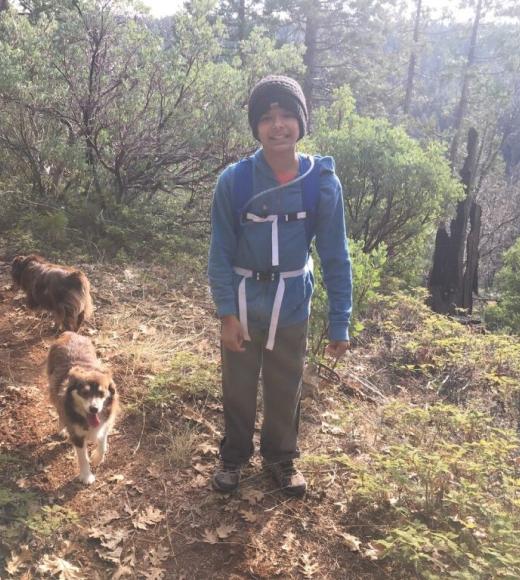
Elliot Jochem (defensible space cultivator, nature lover)Elliott grew up cultivating defensible space at home. Over five to six years, his family worked together to limb trees, thin dense brush, burn and wood-chip slash piles, create a five-foot gravel perimeter around their house, screen vents to block wind-blown embers, install rooftop sprinklers with steel hoses, and remove combustible outdoor furniture from porches before evacuating. When the Caldor Fire swept through his neighborhood, Elliott's home was one of the few that remained standing amidst the community-wide devastation. He began to see signs of renewal: wildflowers emerging from the ash, animals returning, and natural tree seedlings unassumingly establishing the next generation of forest. “If nature can be that resilient,” Elliott says, “I think we can be too.” His advice? "Don't feel overwhelmed—start small. Dedicate a couple of hours each month to cultivating defensible space." He also urges government agencies to conduct forest management and fuel reduction on nearby public lands, creating strategic firebreaks that improve safety for entire communities. Elliott hopes that people living in rural areas will come to understand that healthy and natural forests aren't overly dense, and that with collaboration and long-term commitment, effective stewardship and fire mitigation can take root. “We can work as citizens and as neighbors to better protect our homes—and each other.” |

Logan Chapman (environmental engineer, youth advocate)Logan is an environmental engineer designing remediation systems that clean up pollution from air, soil, and groundwater in areas impacted by oil and gas activities. While a student at South Tahoe High School, Logan co-founded Climate Crew, a youth group for local environmental action. Climate Crew helped to facilitate the school’s transition to electric school buses, reduced meat consumption, and promoted climate lessons. Additionally, Logan contributed to the South Lake Tahoe Climate Action Plan and UC Davis Tahoe Environmental Research Center’s microplastics research. Logan’s advice to young people: “Your voice matters. You may not have all the expertise, but you are creative, and you see things differently than adults. There are endless opportunities to make a difference. Get together, speak up, and take small steps. And for everyone else, support local sustainability efforts, advocate for cleaner infrastructure, and help elevate youth voices. We all have a role to play.” He suggests micro changes such as eating more plant-based meals, biking instead of driving, and learning about environmental issues. Moreover, he encourages consumers to rethink convenience over sustainability and support sustainable business practices. For example, Logan has helped to develop recyclable, sustainable wheels for grocery carts. As Logan writes, “Protecting the planet means protecting the places and people we love.” |
| Lydell Wyatt |

Nettie Purdue (Lake Tahoe Destination Stewardship Council managing director, convener)Nettie leads the Lake Tahoe Destination Stewardship Council to synthesize tourism with environmental and social sustainability. Destination Stewardship is a long-term strategy that aims to create a positive experience for both residents and visitors while also taking care of the environment, culture, and community. The purpose of the Lake Tahoe Destination Stewardship Council is to: 1) Educate and amplify Destination Stewardship in the Tahoe region through communications. 2) Collaboratively increase the efficiency and adoption rates of action-oriented solutions including stewardship efforts, improving the Tahoe Experience for all through recreation infrastructure, peak demand strategies, and litter prevention efforts, and showing the value in the tourism economy. Amidst warming temperatures, more people are visiting the lake, and Nettie strives to prepare Tahoe with enduring infrastructure to support everyone. She points out the “empathy gap” between tourists and residents, suggesting that both can come together to care for Tahoe. Nettie has extensive experience in outdoor education and appreciates the “transformative power” of helping all sorts of people access nature. Nettie’s advice: while in Tahoe, slow down and be mindful. Pick up litter, dispose of waste, engage in sustainable recreation and transportation, and ultimately, respect your surroundings. You can create a positive experience while taking care of the environment, culture, and community. |
Additional Stories
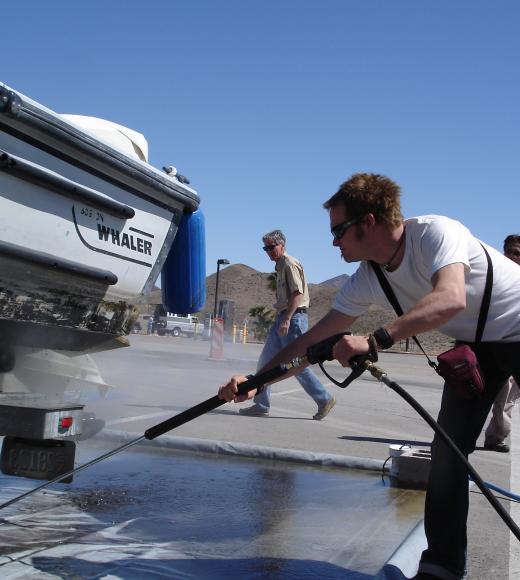
Chris Kilian (Tahoe RCD watercraft inspection program manager, Vermonter)Chris is the watercraft inspection program manager at the Tahoe Resource Conservation District. As environmental changes impact lake clarity, algae growth, and the spread of aquatic invasive species, Chris works to prevent the spread of aquatic invasive species. He encourages the community to clean, drain, and dry watercraft and gear before entering the lake. The Tahoe Keepers stewardship program teaches community members not only these steps, but also how to promote conservation to others. Chris describes his role as “connecting the community to the protections that are necessary for the resources that we enjoy.” |
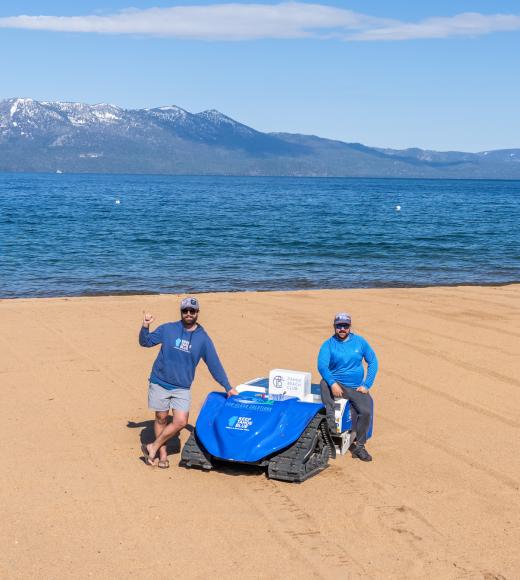
JB Harris (ECO-CLEAN Solutions co-founder, “passionate local”)JB is the co-founder of ECO-CLEAN Solutions, an innovative company that promotes the use of sustainable technology for lakeshore preservation. ECO-CLEAN Solutions has implemented BEBOT, a solar-powered robot that cleans up beach pollution—especially waste that gets buried deeper in the sand. In the process, BEBOT also grabs attention and creates community engagement surrounding technologically-driven environmental solutions. JB encourages, “Tell people about what you saw here today. That’s where the change is going to come from.” Furthermore, he suggests that everyone can make a difference by picking up even one piece of trash as they leave the lakeshore. Cleaning up the beach will inspire future visitors to preserve this pristine nature. |
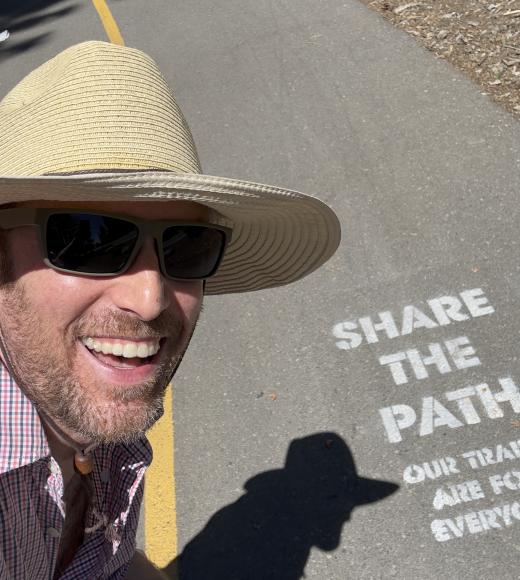
Nathan Laver (BRONTOSAURUS! founder and creative director, Take Care Tahoe co-creator)Nate is the founder and creative director of BRONTOSAURUS!, a creative production house based in Los Angeles that has collaborated with the Tahoe region to design the Take Care Tahoe campaign. Take Care Tahoe promotes clear, positive messaging for better, more eco-conscious decisions and behaviors. For example, Take Care Tahoe motivates audiences to Drink Tahoe Tap and Take it Slow, Tahoe. “The closer you get in a message to something you can take action on as an individual, the more optimistic and inspired you leave people.” Nate himself has a lifelong relationship with Tahoe and is passionate about communicating Tahoe’s ethos of respect for nature and “slowing down to do things right.” Central to the Take Care Tahoe campaign is the idea of communicating quickly and clearly. Nate encourages all Tahoe lovers—both residents and visitors—to take care of yourself, the place, and the people, working together to protect Tahoe’s excellence. |
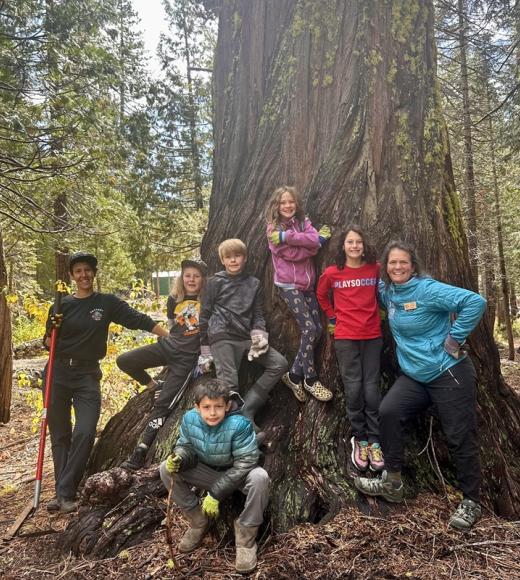
Ashley Phillips (SWEP project director, passionate environmental educator)Ashley is the project director at Sierra Watershed Education Partnerships, connecting K-12 students with the environment through meaningful educational experiences in nature. She notes, “My biggest role is empowering the next generation not just to be aware of environmental issues including climate change, but to feel like they have a voice, and they have a role in helping to solve those problems.” She strives to “inspire and empower students to take action because even just small changes add up to a ripple effect of positive things.” Through SWEP, she has educated students about reducing plastics and protecting against wildfires, among other eco-conscious behaviors. She says that working with students makes her hopeful because “the students that are born into this generation have the unique skillset to be able to solve these problems.” |
